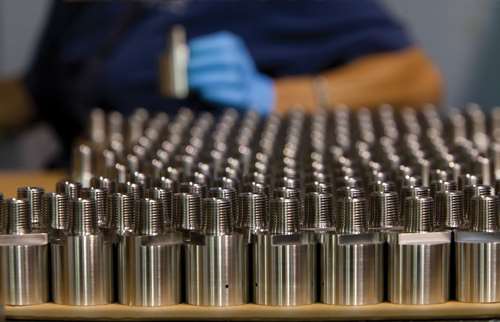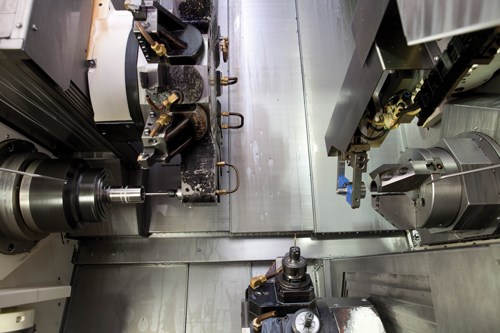Single-Cell Automation Simplifies Shop's Growing Production
Ask Michael Olano, president of Dynomach Inc., how to be a profitable high-volume production shop. His answer: self-contained, single-cell automation, or more specifically, twin-spindle machines outfitted with bar feeders and automatic parts catchers.
#Industry40 #basics
Ask Michael Olano, president of Dynomach Inc., how to be a profitable high-volume production shop. His answer: self-contained, single-cell automation, or more specifically, twin-spindle machines outfitted with bar feeders and automatic parts catchers.
For Dynomach (Port Allen, La.), twin-spindle machine technology allows the 14-person shop to cost effectively keep pace with continuously increasing job volumes. The machines not only provide increased capacity; they virtually eliminate work in progress to help boost the shop’s cash flow. Parts no longer move from one machine to the next for various operations. Instead, they are loaded once, get machined complete in a single setup and then unloaded.
Featured Content
When it first opened its doors 1979, Dynomach repaired pumps and manufactured a variety of parts. Business continued to grow, and with it, production volumes. Currently, lot sizes run anywhere from two prototype parts to 8,000 pieces for regularly occurring orders. And, at any given time, the shop can have at least ten or more large blanket orders in active production as well as its other jobs.
The shop now produces mostly control valve components used in various industries, including oil and gas, oceanographic mapping and chemical. Approximately 90 percent of these parts are made from 316 stainless steel and require milling, turning, drilling, treading and thread milling operations. They range in size from 0.250 inch to 3 inches in diameter and from 2 inches to 5 inches long with tolerances that must be held between 0.0005 inch to 0.001 inch.
According to Mr. Olano, the progression from multiple machines to single-cell, twin-spindle automated part processing occurred in stages, each involving the acquisition of a different machine type, offering different, yet production-enhancing, processes and part size capabilities. Four such twin-spindle machines are the shop’s Integrex-III 200 S five-axis multitasking machine, its Multiplex 6200Y turning center, its Hyperquandrex 200 MSY turning center and a Quick Turn Nexus 250 MSY turning center, all from Mazak Corporation.
To create self-contained automated cells, Dynomach equipped all these machines with bar feeders for continuous operation.
As the shop progressed from one type of machine tool technology to the next, so did several of its parts in an effort to continuously reduce cycle times. The shop was able to slash one control valve component the shop had been producing for 15 years from a 60-minute completion time to only 15 minutes and eliminate having to process it using multiple machines.
At first, the shop machined the part using two lathes and a mill. The shop then moved the job over to its multitasking machine and immediately cut cycle time in half to only 30 minutes and processed the part complete using one machine. Then, because the part involved mostly turning operations, the shop decided to machine it on the Multiplex turning center and was able to reduce process time to 25 minutes. Then, when Dynomach acquired the Hyperquandrex, the job moved to that machine where process time dropped to 15 minutes. And for this component’s mating parts, the shop made the same transitions to go from 50-minute processing times to 30 minutes to 17 minutes and finally to only 10 minutes.
Dynomach is able to shorten part cycle times and achieve automated part processing through the done-in-one capabilities of its Mazak machines. With sequential processing, Dynomach will complete a part’s front-end work in the first spindle. The part will then transfer to the second spindle in a coordinated hand-off for its backwork. While that happens, a new part loads into the first spindle, and the process repeats with parts coming off machines completely finished.
Tool Capacity is Key
Mr. Olano explained that tool capacity is key to the shop’s self-contained, single-cell automation strategy. In fact, he said the need for increased tool capacity and advanced milling capabilities drove the acquisition of the multitasking machine. The shop had to machine a part that involved flats and holes and a contoured shape. But its existing machines at the time lacked the necessary axis travel and tool capacity for the particular part that required 31 tools during processing. The multitasking machine not only provided more than enough room for the tooling in its tool magazine, but it expanded the shop’s part-processing versatility with the addition of five-axis machining capability.
“We needed to make 200 parts per week for an 8,000-piece annual blanket order,” Mr. Olano says. “Our first thought was [to purchase] two dedicated turning machines and a standalone robot. But with a 32-tool capacity, along with twin spindles and twin turrets, we automated processing and machine the parts complete with our one turning center and without the added cost of a robot.”
Balance Equals Shortest Cycle Times
“On twin spindle, twin turret machines, the longest operation cycle time becomes a part’s overall cycle time,” Mr. Olano says. “This means that the spindle in which a part spends the most time is the one that determines cycle time. So to achieve the shortest cycle times, there must be a balance between the two spindles, and we obtain this balance by dividing our part operations, as equally as possible time-wise, between a machine’s two spindles.”
One drilled hole may require as many as four separate tools at Dynomach, and to gain balance, according to Mr. Olano, the shop will first consider several factors: Does the part geometry allow the hole to be drilled in either the main or second spindle, or are there multiple holes of the same size in the part and where are they located? If holes can be drilled in either spindle, the shop then decides—based on turret tool loads and affect on part cycle time—to either drill the holes during front-working operations or backworking ones.
He adds that there are no steadfast rules to follow for the best way to balance operations and tooling. It is basically trial and error, and shops have to keep testing different approaches with the same types of parts until they find a particular balance that works. And while at first achieving balance can be a challenge and a bit time consuming, the process gets easier and quicker the more a shop works with its twin spindle, twin turret machine tools.
Mr. Olano explains that as the shop continues to shorten cycle times, it, in turn, opens up additional machine capacity. “With more capacity, our existing customers are giving us even more work,” he says. “And as that demand increases, we will depend on our reliable and accurate Mazak machines for self-contained, single-cell automation to cost effectively meet those surging production needs.”
RELATED CONTENT
-
5 Grinding Considerations for Improving Surface Finish
Improving surface finish can be done by making adjustments to one or more of these points: operational parameters, wheel dressing, grit size, coolant delivery and machine condition.
-
Understanding CNC Collet Chucks
Workholding for turning is usually fairly basic: The selection comes down to chucks or collets. This article looks at when to consider the collet chuck and what kind might be best for a given application.
-
Understanding Micro-Milling Machine Technology
Micro-milling can be a companion process to turning-based production machining. This article looks at some of the technologies that go into a micro-milling machine and why they are important to successful operation.








